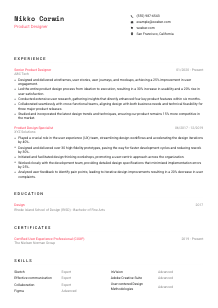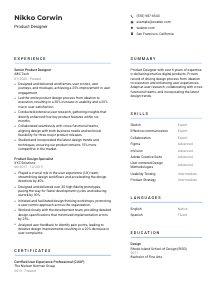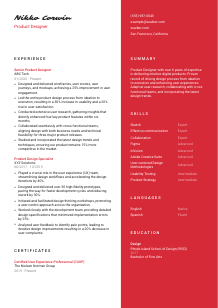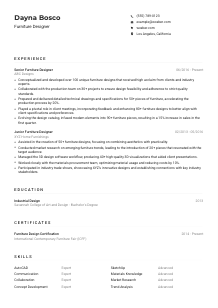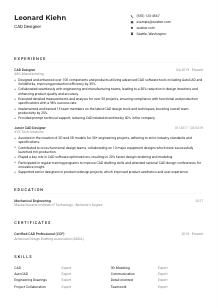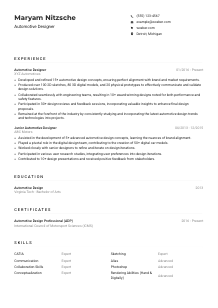Product Designer CV Example
Molding innovative product concepts, but your CV doesn't fit the prototype? Sculpt your qualifications into shape with this Product Designer CV example, crafted using Wozber free CV builder. Discover how to harmonize your design details with job specifications, bridging the gap between creativity and career growth!
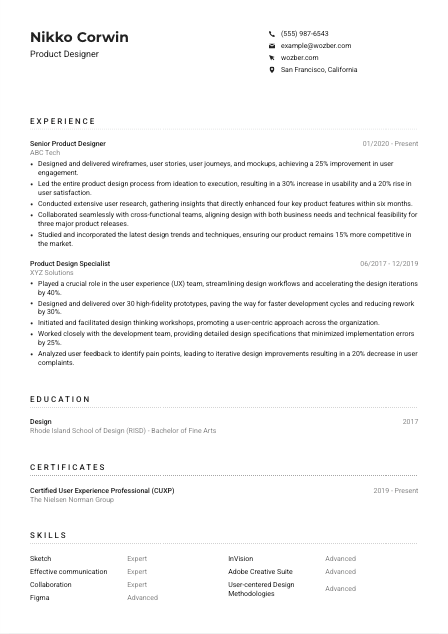
How to write a Product Designer CV?
Hey there, future Product Design wizard! In a world where first impressions are digital, your CV isn't just paper or pixels—it's your golden ticket to the interview room. But not any CV will do; you need one that speaks the language of Product Design and sings to the tune of an Applicant Tracking System (ATS). Fear not, because with this masterclass, powered by Wozber's free CV builder, you're going to craft an ATS-compliant CV that stands out.
Ready to turn your career dreams into plans? Let's dive deep into the craft of creating a targeted Product Designer CV that's both ATS-friendly and distinctly yours.
Personal Details
Setting the stage for your narrative starts here, in the seemingly straightforward section of Personal Details. Yet, this is where your first connection with the hiring manager is forged. It's pivotal to get this right, aligning it with the intricate necessities of a Product Designer role. We'll unpack how to brush up your contact info with a touch of design thinking.
1. Your Name as a Personal Logo
Think of your name at the top of your CV not just as text but as your personal brand logo. Does it grab attention? Make sure it's in a legible font that stands out—just like how a well-designed logo captures the essence of a brand.
2. Job Title Alignment
Directly below your name, mirror the job title you're applying for, i.e., 'Product Designer'. This is not only about ATS optimisation but also about instantly showing your alignment with the role. This tip boosts the match rate in ATS algorithms and psychologically aligns the reader's perception of you with the position.
3. Essential Contacts Only
Stick to the essentials: phone number and professional email (opt for firstname.lastname@email.com format). Remember, in the realm of Product Design, simplicity speaks volumes. Double-check for accuracy; a typo here could sever your connection to your future employer.
4. Location Matters
The role's geo-specific requirements, such as 'Must be located in San Francisco, California,' should reflect in your details. If you match this, make it evident. It subtly assures the hiring manager of your logistical fit for the role.
5. Digital Presence
Do include your LinkedIn or portfolio website, ensuring they're polished and updated. Your online portfolio is crucial for a Product Designer role, acting as an extension of your CV that showcases your practical skills and design philosophy.
Takeaway
In sum, the Personal Details section is more than just functional; it's the first brushstroke on your professional canvas. Make it clean, make it resonant, and ensure it aligns seamlessly with the Product Designer role you're targeting. It's your initial chance to communicate your attention to detail and design ethos—crucial elements for any successful Product Designer.





Experience
Your experience section is where you capture and convey your professional journey—a story of challenges, learnings, and achievements. For a Product Designer, this isn't just about listing what you've done but illustrating your impact and innovation along the way. Let's break down how to craft this narrative in a way that resonates with the essence of Product Design.
- Designed and delivered wireframes, user stories, user journeys, and mockups, achieving a 25% improvement in user engagement.
- Led the entire product design process from ideation to execution, resulting in a 30% increase in usability and a 20% rise in user satisfaction.
- Conducted extensive user research, gathering insights that directly enhanced four key product features within six months.
- Collaborated seamlessly with cross‑functional teams, aligning design with both business needs and technical feasibility for three major product releases.
- Studied and incorporated the latest design trends and techniques, ensuring our product remains 15% more competitive in the market.
- Played a crucial role in the user experience (UX) team, streamlining design workflows and accelerating the design iterations by 40%.
- Designed and delivered over 30 high‑fidelity prototypes, paving the way for faster development cycles and reducing rework by 30%.
- Initiated and facilitated design thinking workshops, promoting a user‑centric approach across the organisation.
- Worked closely with the development team, providing detailed design specifications that minimized implementation errors by 25%.
- Analyzed user feedback to identify pain points, leading to iterative design improvements resulting in a 20% decrease in user complaints.
1. Mapping the Requirements
First off, dissect the job's requirements meticulously. For example, if the job description emphasizes, 'Design and deliver wireframes, user stories, user journeys, and mockups,' ensure your previous roles reflect this. Align your accomplishments so they respond like an answer to each requirement.
2. Roles and Responsibilities
List your positions in reverse chronological order, focusing on those where you've had direct impact as a Product Designer. Beyond just duties, articulate how you've led projects, innovated solutions, or enhanced user experiences.
3. Quantifiable Success
Numbers speak louder than adjectives. Did your design lead to a 25% increase in user engagement? Mention it! Quantify your achievements to offer tangible proof of your contributions, making your impact clear and compelling.
4. Relevance is Key
It can be tempting to list every job you've ever had, but focus on those most relevant to Product Design. Each bullet point should serve as evidence of your suitability for the role you're targeting.
5. ATS Compatibility
Seamlessly incorporate keywords from the job description into your experience section. ATS scanners look for these keywords, making it essential for passing the first digital gatekeeper. Use terms like 'user research,' 'wireframes,' and 'cross-functional collaboration' as they directly relate to typical Product Designer responsibilities.
Takeaway
Each entry in your Experience section is a chapter of your Product Design story. It's about painting a picture of your professional evolution and its relevance to the role at hand. Keep it succinct, targeted, and imbued with the essence of your design journey. Remember, an optimised, ATS-compliant CV from Wozber can help ensure your story gets in front of the eyes that matter.
Education
Your educational background is the foundation upon which your Product Design journey is built. It demonstrates your initial commitment to the craft and understanding of design principles. Here's how you can sculpt this section to resonate with the core requirements of a Product Designer role.
1. Echo the Job's Educational Needs
If the job requires a 'Bachelor's degree in Design, Human-Computer Interaction, or a related field,' make sure your education section reflects this. Tailor your degree title to match the job specifications closely, if applicable.
2. Simplicity and Clarity
Organize your educational credentials in a clear, easy-to-scan format. Begin with your most recent degree, including the field of study, degree type, and the institution, followed by graduation date.
3. Relevant Courses and Projects
Particularly for early career professionals, highlighting specific courses or projects can help compensate for a shorter work history. Mention any design-related courses or projects that showcase your relevant skills.
4. Achievements and Recognitions
Did you graduate with honors, or were you involved in any design-centric clubs or organisations? While they may hold more weight for newer graduates, such accolades can also underscore your dedication and passion for the field.
5. Continuing Education
The design world is ever-evolving. If you've taken courses or obtained certificates post-graduation (like the 'Certified User Experience Professional' from the Nielsen Norman Group), mention them. They speak to your ongoing commitment to staying current in the field.
Takeaway
Your Education section is not mere formality; it's a testament to your foundational knowledge and continual growth within the design domain. Present it with precision and pride, ensuring it aligns with the desired Product Designer role. Remember, utilizing Wozber's ATS-friendly CV template can help streamline this process, setting the stage for your success.
Certificates
In the fast-paced world of Product Design, certificates are your badges of honor. They showcase your dedication to refining your skills and staying ahead of industry standards. Here's how to leverage your certificate section to showcase your relentless pursuit of excellence.
1. Select with Purpose
Prioritize certificates closely aligned with the requirements of the Product Designer role. For instance, a 'Certified User Experience Professional' directly speaks to the core competencies expected in the job description.
2. Date and Detail
For each certificate, make sure to include the name of the issuing organisation and the date of issuance or expiry if applicable. This information provides context and emphasizes the currency of your skills.
3. Quality Over Quantity
It can be tempting to list every certificate you've ever earned, but focus on those most relevant to Product Design. This targeted approach ensures your CV is concise and tailored, making a stronger impact.
4. Continuous Learning
Product Design is a field that constantly evolves. Highlight your commitment to staying updated with the latest trends and techniques through ongoing learning and certification. This attitude towards self-improvement makes you an asset to any team.
Takeaway
Certificates are a powerful way to substantiate your skills and passion for Product Design. They tell a story of a professional who is not content with the status quo but is actively seeking to grow and evolve. By carefully selecting and presenting your certifications, you reassure potential employers of your commitment and aptitude for the role.
Skills
The Skills section of your CV is your professional arsenal—your chance to showcase the tools and talents you bring to the Product Designer role. In this craft, it's not just about listing skills; it's about aligning them with the specific demands of the position. Let's refine your skills section to reflect your adeptness in both design and collaboration.
1. Unpack the Job Description
Start by dissecting the job description for explicit and implicit skill requirements. For instance, 'Proficiency in design software' could translate to specific skills like 'Sketch', 'Figma', and 'Adobe Creative Suite'. Make sure these are prominently listed.
2. Highlight Pertinent Skills
Include both technical skills, like software proficiencies, and soft skills, such as 'effective communication' and 'collaboration'. The latter are often just as critical in a cross-functional role like Product Design, where articulating your vision and working with others is key.
3. Concise and Targeted
Your skills section should be a curated list, not an exhaustive one. Select skills that best match the job description and those you can confidently discuss. This focus ensures clarity and impact, avoiding any dilution of your core competencies.
Takeaway
The skills you list are a promise of the value you bring to the table. Highlighting those that resonate with the product design domain ensures you're seen as a tailor-fit for the role. It's not just about having skills; it's about having the right ones and presenting them effectively. With Wozber's tools for ATS optimisation, your skills won't just be seen—they'll stand out.
Languages
As a Product Designer, the ability to effectively communicate in multiple languages can be a valuable asset, especially in roles that involve international teams or markets. Let's talk about positioning your linguistic skills as a bridge to global design opportunities.
1. Verify Job Language Requirements
Initial clues about language requirements may be hidden in the job description. Highlighting your proficiency in English, as explicitly requested, is a must. Include this at the top of your language list, marked as 'Native' or 'Fluent'.
2. Prioritize Relevant Languages
After English, list any additional languages you speak. While the job description might not specify them, being conversant in another language can position you as a valuable team member in a globally diverse workspace.
3. Level of Proficiency
Be precise and honest about your language proficiency levels. Whether it's 'Fluent', 'Intermediate', or 'Basic', provide a true reflection of your capabilities. It helps set realistic expectations and can prevent any potential misunderstandings.
4. Global Focus
For roles that hint at a regional or global interaction, your ability to communicate in multiple languages puts you ahead. It shows you're equipped not just to design but to engage, understand, and collaborate on a broader stage.
5. Continuous Improvement
Languages open doors—both literally and metaphorically. If you're in the process of learning a new language, mention it. It indicates a commitment to personal and professional growth, a trait that's highly valued in dynamic fields like Product Design.
Takeaway
Your linguistic skills are not just personal assets; they're professional tools that can significantly enhance your productivity and outreach in the global design community. By showcasing these skills thoughtfully, you open up a world of opportunities—making it clear you're not just a designer, but a global communicator. It's another compelling reason why hiring managers should give your CV a closer look.
Summary
The Summary section of your CV is a tightly packed showcase of your professional narrative. It's your elevator pitch—concise, compelling, and crucially aligned with the Product Designer role you're targeting. Here's how to craft a summary that not only introduces you but intrigues them.
1. Capture Your Essence
Begin with a statement that summarizes who you are professionally. As a Product Designer, this might include your years of experience, your design philosophy, or a standout achievement that sets the tone for the dynamism and depth of your career.
2. Address Core Requirements
Weave in skills and achievements that directly respond to the job's core requirements. If the role emphasizes 'user-centered design', mention how your design process has always prioritized end-user experience and satisfaction.
3. Distill, Don't Dilute
Keep your summary crisp and to the point. Three to five dynamic sentences are all you need to make a strong statement. This isn't just about brevity—it's about impact. Every word should serve a purpose, echoing the essence of your Product Design expertise.
4. ATS Alignment
Infuse your summary with keywords from the job listing, like 'wireframes', 'user research', and 'cross-functional collaboration'. This strategic placement not only captivates human readers but ensures your CV sings in tune with ATS algorithms.
Takeaway
Your summary is the handshake before the conversation—it's brief, but it's powerful. It offers a glimpse into your professional soul, making the case for why you're not just a candidate but the candidate for the Product Designer role. Craft it with care, and remember, Wozber's free CV builder and ATS CV scanner are here to guide your every step, ensuring your summary—and the rest of your CV—is nothing short of compelling.
Launching Your Product Designer Journey
Congratulations, you've now armed yourself with the insights and strategies to craft a Product Designer CV that resonates, communicates, and impacts. This isn't just about landing a job; it's about opening a new chapter in your design story. With a CV that's both ATS-friendly and rich in substance, you're not just stepping into the job market—you're stepping up to meet your destiny. Wozber is here to help refine your narrative with a free CV builder that makes ATS optimisation intuitive.
Your journey as a Product Designer begins with a single step. Take it boldly, take it with Wozber, and let your career unfold in ways you've always envisioned.

- Bachelor's degree in Design, Human-Computer Interaction, or a related field.
- Minimum of 3 years of relevant experience in product design or a related role.
- Proficiency in design software such as Sketch, Figma, InVision, or Adobe Creative Suite.
- Strong understanding of user-centered design processes and methodologies.
- Effective communication, collaboration, and presentation skills.
- Must possess good command over English language.
- Must be located in San Francisco, California.
- Design and deliver wireframes, user stories, user journeys, and mockups optimized for various digital platforms.
- Drive the product design process from ideation to execution ensuring a smooth and intuitive user experience.
- Conduct user research and evaluate user feedback to continuously enhance the product.
- Collaborate with cross-functional teams including product managers, developers, and researchers to align the design with business needs and technical feasibility.
- Stay updated with the latest design trends, techniques, and tools to ensure the product remains competitive.





